Describe 5 strategic decisions a company can make and how these decisions could impact upon competitive advantage.
See the complete answer below in Explanation.
Five Strategic Decisions a Company Can Make and Their Impact on Competitive Advantage
Strategic decisions shape a company's direction and influence its long-term success. Below are five key strategic decisions and their impact oncompetitive advantage:
1. Market Entry Strategy
Decision:A company decides how to enter new markets (e.g., direct investment, joint ventures, exporting, franchising).
Impact on Competitive Advantage:✅Global Reach:Expanding into new markets increases revenue streams and reduces dependency on a single market.✅Risk Mitigation:Entering viajoint venturesoralliancescan reduce risks related to market unfamiliarity.✅Brand Positioning:Choosingpremium vs. cost-leadership entry strategiescan establish market dominance.❌Potential Risk:Poor market research can lead to financial loss and reputational damage.
Example:Tesla entering China through direct investment inGigafactoriesto strengthen its supply chain and reduce production costs.
2. Supply Chain Strategy
Decision:Whether to adopt aglobalized, localized, or hybridsupply chain model.
Impact on Competitive Advantage:✅Cost Reduction:Strategic sourcing fromlow-cost countrieslowers production expenses.✅Resilience:Adiverse supplier basereduces risks of disruptions (e.g., geopolitical risks, pandemics).✅Speed to Market:Nearshoring strategies improve lead times and response to demand fluctuations.❌Potential Risk:Over-reliance on global suppliers can lead to disruptions (e.g., semiconductor shortages).
Example:Apple’s dual sourcing strategy for chip manufacturing (Taiwan’s TSMC + US-based suppliers) improves resilience.
3. Innovation and R&D Investment
Decision:How much to invest inresearch and development (R&D)to drive product innovation.
Impact on Competitive Advantage:✅Differentiation:Unique and high-quality products create strong brand loyalty (e.g., iPhones, Tesla).✅First-Mover Advantage:Innovators set industry trends, making it difficult for competitors to catch up.✅Revenue Growth:New technologies create additional revenue streams (e.g., SaaS models in tech).❌Potential Risk:High R&D costs with no guaranteed success (e.g., Google Glass failure).
Example:Pfizer and BioNTech’s rapid COVID-19 vaccine development, giving them first-mover advantage.
4. Pricing Strategy
Decision:Whether to compete oncost leadership, differentiation, or premium pricing.
Impact on Competitive Advantage:✅Market Penetration:Low-cost pricing attractsprice-sensitivecustomers (e.g., Walmart, Ryanair).✅Brand Exclusivity:Premium pricing enhances brand perception and profitability (e.g., Rolex, Louis Vuitton).✅Value-Based Pricing:Aligning price with perceived value increases customer retention.❌Potential Risk:A race to the bottom in pricing wars can erode profit margins (e.g., budget airlines struggle with profitability).
Example:Apple uses apremium pricing strategywhile Xiaomi competes viacost leadershipin smartphones.
5. Digital Transformation Strategy
Decision:Investment inautomation, AI, and digital platformsto improve efficiency and customer engagement.
Impact on Competitive Advantage:✅Operational Efficiency:Automation reduces costs and increases productivity (e.g., Amazon’s AI-driven warehouses).✅Customer Experience:AI-driven personalization improves engagement (e.g., Netflix’s recommendation algorithms).✅Scalability:Digital platforms enable rapid global expansion (e.g., Shopify helping SMEs go digital).❌Potential Risk:High initial investment with slow ROI; risk of cyber threats.
Example:Starbucks using AI-poweredpersonalization and mobile orderingto increase sales and customer loyalty.
Conclusion
Each strategic decision influences a company’s competitive positioning. The most successful companies alignmarket expansion, supply chain strategies, innovation, pricing, and digital transformationto create asustainable competitive advantage.
Evaluate the following approaches to strategy formation: intended strategy and emergent strategy
See the complete answer below in Explanation.
Evaluation of Intended Strategy vs. Emergent Strategy
Introduction
Strategy formation is acritical processthat determines how businesses achieve their objectives. Two contrasting approaches exist:
Intended Strategy– Adeliberate, planned approach, where management defines a clear course of action.
Emergent Strategy– Aflexible, adaptive approach, where strategy evolves in response to external changes.
Both approaches have advantages and constraints, and organizations oftencombine bothto maintain strategic direction while adapting to market uncertainties.
1. Intended Strategy????(Planned Approach to Strategy Formation)
Definition
Anintended strategyis astructured, pre-planned approachwhere an organizationsets long-term goals and develops a roadmap to achieve them.
✅Key Characteristics:
Clearly defined mission, vision, and objectives.
Top-down decision-makingwith structured implementation plans.
Focus onforecasting, market research, and competitor analysis.
????Example:
McDonald’s follows an intended strategyby expanding its franchise model using structured business plans and operational guidelines.
Advantages of Intended Strategy
✔Provides a clear vision and direction– Ensures all departments align with corporate goals.✔Supports long-term resource allocation– Helps in budgeting and investment planning.✔Enhances risk management– Allows organizations to prepare for potential challenges.✔Ensures consistency– Ideal forstable industries with predictable market conditions.
Constraints of Intended Strategy
❌Inflexible in dynamic markets– Struggles with unforeseen changes (e.g., economic crises, technology shifts).❌Can lead to missed opportunities– Focuses on execution rather than adaptation.❌Slow response time– Delays decision-making in fast-changing industries.
????Key Takeaway:Intended strategy works best instable environmentswhere long-term planning can be executedwithout major disruptions.
2. Emergent Strategy????(Flexible & Adaptive Approach to Strategy Formation)
Definition
Anemergent strategyis aresponsive, flexible approachwhere businessesadapt their strategies based on real-time changesin the market.
✅Key Characteristics:
Strategy emerges fromtrial and error, experimentation, and learning.
Encouragesbottom-up decision-making, allowing employees to contribute.
Focuses onshort-term flexibility and continuous adjustments.
????Example:
Amazon’s move into cloud computing (AWS)was an emergent strategy, as it originally started as an online bookstore but adapted to market opportunities.
Advantages of Emergent Strategy
✔Highly adaptable– Allows businesses to pivot in response to market shifts.✔Encourages innovation and experimentation– Promotes new ideas and flexible problem-solving.✔Reduces risk of failure– Companies can adjust strategiesbefore fully committing to large-scale investments.✔Works well in unpredictable environments– Essential for industries liketechnology, fashion, and e-commerce.
Constraints of Emergent Strategy
❌Lack of clear direction– Can create confusion in organizations with no defined strategic goals.❌Resource inefficiency– Constant adjustments may lead to wasted time and investment.❌Difficult to scale– Unstructured decision-making can cause inconsistencies.
????Key Takeaway:Emergent strategy isideal for fast-changing industrieswhere adaptability is more valuable than rigid planning.
3. Comparison: Intended Strategy vs. Emergent Strategy
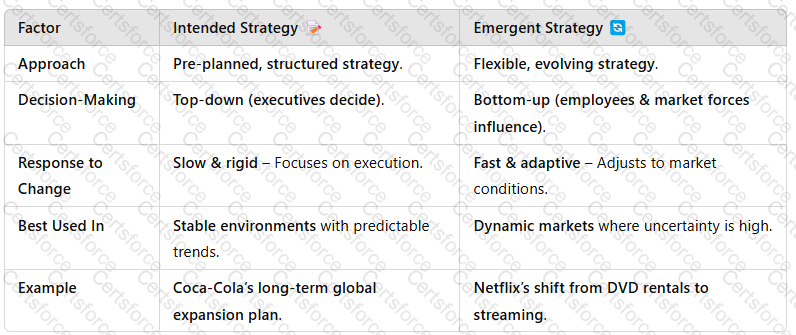 A screenshot of a computer
Description automatically generated
A screenshot of a computer
Description automatically generated
Key Takeaway:Most successful organizationsblend both approaches, usingintended strategy for stabilityandemergent strategy for adaptability.
4. Conclusion
Bothintended and emergent strategieshave strengths and weaknesses.
✅Intended strategyisbest for structured, long-term growthin stable industries.✅Emergent strategyallows forrapid adaptationin volatile markets.✅Most businesses use a combinationof both approaches, balancingplanning with flexibility.
Byintegrating intended and emergent strategies, organizations canmaintain stability while responding effectively to market changes.
XYZ is a toilet paper manufacturer based in the UK. It has 2 large factories employing over 500 staff and a complex supply chain sourcing paper from different forests around the world. XYZ is making some strategic changes to the way it operates including changes to staffing structure and introducing more automation. Discuss 4 causes of resistance to change that staff at XYZ may experience and examine how the CEO of XYZ can successfully manage this resistance to change
See the complete answer below in Explanation.
Causes of Resistance to Change & Strategies to Manage It – XYZ Case Study
When XYZ, a UK-based toilet paper manufacturer, implementsstrategic changessuch asstaff restructuring and automation, employees mayresist changedue to uncertainty, fear, and disruption to their work environment. Below arefour key causes of resistanceand how theCEO can manage them effectively.
Causes of Resistance to Change
1. Fear of Job Loss
????Cause:Employees may fear thatautomationwill replace their jobs, leading to layoffs. Factory workers and administrative staff may feel particularly vulnerable.
????Example:If machines take over manual processes like paper cutting and packaging, employees may see this as a direct threat to their roles.
2. Lack of Communication and Transparency
????Cause:When managementfails to communicatethe reasons for change, employees may speculate and assume the worst.Unclear messageslead to distrust.
????Example:If XYZ’s CEO announces restructuring without explainingwhyandhowjobs will be affected, employees may feel insecure and disengaged.
3. Loss of Skills and Status
????Cause:Some employees, especiallylong-serving workers, may feel their skills are becoming obsolete due to automation.Managersmay resist change if they fear losing power in a new structure.
????Example:A production line supervisor mayoppose automationbecause it reduces the need for human oversight, making their role seem redundant.
4. Organizational Culture and Habit
????Cause:Employees are accustomed tospecific ways of working, andsudden changes disrupt routine. Resistance occurs when changes challengeexisting work culture.
????Example:XYZ’s employees may havealways used manual processes, and shifting toAI-driven productionfeels unfamiliar and uncomfortable.
How the CEO Can Manage Resistance to Change
1. Effective Communication Strategy
✅What to do?
Clearly explainwhy the changes are necessary(e.g., cost efficiency, competitiveness).
Usetown hall meetings, emails, and team discussionsto provide updates.
Addressemployee concernsdirectly to reduce uncertainty.
????Example:The CEO can sendmonthly updateson automation, ensuring transparency and reducing fear.
2. Employee Involvement and Engagement
✅What to do?
Involve staff indecision-makingto give them a sense of control.
Createcross-functional teamsto gather employee input.
Provide opportunities forfeedback and discussion.
????Example:XYZ canform a worker’s advisory panelto gather employee concerns and address them proactively.
3. Training and Upskilling Programs
✅What to do?
Offertraining programsto help employees adapt to new technologies.
Providereskilling opportunitiesfor employees whose jobs are affected.
Reassure staff that automation willcreate new roles, not just eliminate jobs.
????Example:XYZ can introducedigital skills trainingfor workers transitioning from manual processes to automated systems.
4. Change Champions & Support Systems
✅What to do?
Appointchange champions(influential employees) to advocate for change.
Offeremotional and psychological support(e.g., HR consultations, career guidance).
Recognize and reward employees whoembrace change.
????Example:XYZ can offerbonuses or promotionsto employees who successfully transition into new roles.
Conclusion
Resistance to change is natural, but theCEO of XYZ can minimize resistancethroughclear communication, employee involvement, training, and structured support. By managing resistance effectively, XYZ can ensure asmooth transitionwhile maintaining employee morale and operational efficiency.
Describe and evaluate the use of the VRIO Framework in understanding the internal resources and competencies of an organisation.
See the complete answer below in Explanation.
The VRIO Framework: Understanding Internal Resources and Competencies
TheVRIO Frameworkis a strategic analysis tool used to assess an organization’sinternal resources and competenciesto determine whether they provide asustainable competitive advantage. Developed byJay Barney, VRIO stands forValue, Rarity, Imitability, and Organization.
1. Explanation of the VRIO Framework
The VRIO model evaluates whether a firm’s resources and capabilities contribute to asustained competitive advantage.
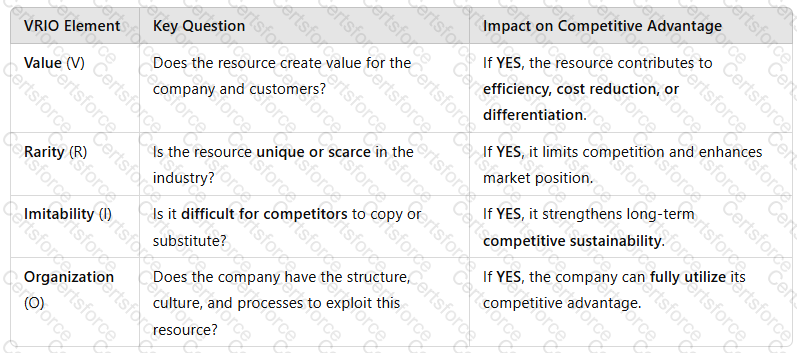 A screenshot of a survey
Description automatically generated
A screenshot of a survey
Description automatically generated
Example:Apple’s software ecosystem (iOS, App Store)isvaluable, rare, hard to imitate, and well-organized, giving it asustainable competitive advantage.
2. The Use of VRIO in Assessing Internal Resources and Competencies
Companies use the VRIO framework to identifywhich resources provide temporary or sustainable competitive advantages.
 A screenshot of a computer
Description automatically generated
A screenshot of a computer
Description automatically generated
3. Advantages of Using VRIO in Strategic Decision-Making
✅Identifies Core Competencies– Helps organizations focus onkey strengthsthat drive long-term success.✅Guides Investment Decisions– Encourages businesses to invest in resources that aredifficult to imitate.✅Improves Competitive Strategy– Helps firms differentiate betweenshort-term vs. long-term advantages.
????Example:Coca-Cola’s brand equityis VRIO-positive, making it difficult for new entrants to replicate.
4. Limitations of the VRIO Framework
❌Ignores External Factors– UnlikePESTLE or Porter’s Five Forces, VRIO does not account formarket conditions or regulatory changes.❌Subjectivity in Resource Evaluation– Assessing whether a resource is trulyvaluable or rarecan be complex.❌Lack of Actionable Steps– VRIOidentifies competitive strengthsbut doesnot provide strategiesfor leveraging them.
????Example:A company mayidentify a rare talent pool, butpoor organizational structure(O) can prevent it from leveraging this advantage.
5. Application of VRIO in Business Strategy
Businesses across different industries use VRIO to assess their internal strengths:
 A screenshot of a computer
Description automatically generated
A screenshot of a computer
Description automatically generated
Conclusion
TheVRIO Frameworkis a valuable tool for evaluatinginternal resources and capabilities, allowing businesses to identifysustainable competitive advantages. However, it should beused alongside external analysis tools(e.g.,PESTLE, SWOT) to ensure acomprehensive strategic assessment.
Discuss supply and demand factors in foreign exchange
See the complete answer below in Explanation.
Supply and Demand Factors in Foreign Exchange
Introduction
Theforeign exchange (Forex) marketoperates on the fundamental principle ofsupply and demand, which determines currency values. Whendemand for a currency rises, its value appreciates, whilean oversupply causes depreciation.
Several factors influence thesupply and demandof foreign currencies, includinginterest rates, inflation, trade balances, investor sentiment, and geopolitical events.
This answer explores thekey supply and demand factors in Forex marketsand how they impact exchange rates.
1. Demand Factors in Foreign Exchange????????(What Increases Demand for a Currency?)
1.1 Interest Rate Differentials????(Higher Interest Rates Attract Capital Inflows)
✅Why It Affects Demand?
Investors seekhigher returns on savings and investments.
Higher interest ratesincrease demandfor the country’s currency.
????Example:
When theUS Federal Reserve raises interest rates, theUS dollar (USD) strengthensas global investors buyUSD-denominated assets.
????Key Takeaway:Countries withhigher interest rates attract more investors, increasing currency demand.
1.2 Inflation Rates????(Low Inflation Strengthens Currency Demand)
✅Why It Affects Demand?
Lower inflation preserves purchasing power, making the currency more attractive.
High inflationerodes currency value, reducing demand.
????Example:
TheSwiss Franc (CHF) remains strongdue to Switzerland’slow inflation and economic stability.
In contrast,Turkey’s Lira (TRY) depreciateddue to high inflation, reducing investor confidence.
????Key Takeaway:Stable inflation rates encourage demand for a currency, while high inflation weakens it.
1.3 Trade Balance & Current Account Surplus????(Export-Led Demand for a Currency)
✅Why It Affects Demand?
Atrade surplus(exports > imports) increases demand for a country’s currency.
Foreign buyers need the country’s currency topay for goods and services.
????Example:
China’s trade surplus increases demand for the Chinese Yuan (CNY)as global buyers purchase Chinese goods.
Germany’s strong exports strengthen the Euro (EUR)due to high international trade.
????Key Takeaway:Exporting nations experiencehigher currency demand, boosting value.
1.4 Investor Confidence & Speculation????(Market Sentiment Drives Demand)
✅Why It Affects Demand?
If investorsexpect a currency to appreciate, they buy more of it.
Safe-haven currencies seeincreased demand during global uncertainty.
????Example:
Gold and the US Dollar (USD) strengthen during economic crises, as investors seek stability.
Brexit uncertainty weakened the British Pound (GBP)as investors speculated on UK economic instability.
????Key Takeaway:Market psychology and speculation can drive short-term demand for a currency.
2. Supply Factors in Foreign Exchange????????(What Increases the Supply of a Currency?)
2.1 Central Bank Monetary Policy????(Money Supply & Interest Rate Adjustments)
✅Why It Affects Supply?
Central bankscontrol currency supplythrough interest rates and money printing.
Loose monetary policy (low rates, quantitative easing)increases money supply, depreciating currency.
????Example:
TheEuropean Central Bank (ECB) lowered interest ratesand introduced stimulus packages, increasing thesupply of Euros (EUR).
TheBank of Japan’s low-interest ratesincreased thesupply of Japanese Yen (JPY), making it weaker.
????Key Takeaway:More money supply weakens a currency, while tight monetary policy strengthens it.
2.2 Government Debt & Fiscal Policy????(Higher Debt Increases Currency Supply)
✅Why It Affects Supply?
Countries withhigh national debtmay increase money supply to cover obligations.
High debt reduces investor confidence, increasing supply as investors sell off the currency.
????Example:
TheUS dollar saw increased supplyduring the 2008 financial crisis due to stimulus packages.
Argentina’s peso weakenedas government debt rose, increasing peso supply in markets.
????Key Takeaway:High government debt can lead to more currency supply and depreciation.
2.3 Foreign Exchange Reserves & Currency Intervention????(Central Banks Selling Currency to Manage Value)
✅Why It Affects Supply?
Central banks buy/sell their currency tostabilize exchange rates.
Selling reservesincreases currency supply, reducing its value.
????Example:
China’s central bank occasionally sells Yuan (CNY)to keep it competitive in global markets.
Switzerland’s central bank has intervened to weaken the Swiss Franc (CHF)to support exports.
????Key Takeaway:Governments manipulate currency supply to stabilize economic conditions.
2.4 Import Demand & Trade Deficits????(More Imports Increase Currency Supply)
✅Why It Affects Supply?
Atrade deficit(imports > exports) increases supply of local currency in global markets.
Importers exchange local currency for foreign currency, increasing supply.
????Example:
The US has a persistent trade deficit, increasing thesupply of US dollars in foreign exchange markets.
The UK’s reliance on importshas contributed to GBP fluctuations.
????Key Takeaway:Countries withtrade deficits see higher currency supply, leading to depreciation.
3. Interaction of Supply & Demand in Foreign Exchange Markets
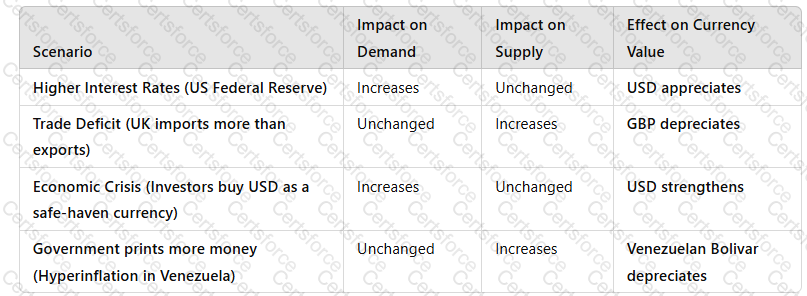 A white grid with black text
Description automatically generated
A white grid with black text
Description automatically generated
Key Takeaway:Exchange rates fluctuate based on thebalance between supply and demand.
4. Conclusion
The foreign exchange market operates based onsupply and demand dynamics, influenced by:
✅Demand Factors:
Interest Rates & Inflation– Higher rates strengthen demand.
Trade Balances– Export-driven economies see strong demand.
Investor Sentiment– Economic stability attracts investors.
✅Supply Factors:
Central Bank Policies– Money printing increases supply.
Government Debt– High debt increases supply, lowering value.
Trade Deficits– Import-heavy economies see currency depreciation.
Understanding these factors helps businesses and policymakersmanage foreign exchange risks and optimize international trade strategies.
XYZ is a large and successful airline which is looking to expand into a new geographical market. It currently offers short haul flights in Europe and wishes to expand into the Asian market. In order to do this, the CFO is considering medium/ long term financing options.Describe 4 options that could be used.
See the complete answer below in Explanation.
Four Medium/Long-Term Financing Options for XYZ’s Expansion into Asia
Introduction
Expanding into anew geographical marketrequiressignificant capital investmentfornew aircraft, operational infrastructure, marketing, and regulatory approvals. As XYZ Airlines plans to enter theAsian market, the CFO must assessmedium and long-term financing optionsto fund this expansion while managing risk and financial stability.
The following arefour key financing optionsthat XYZ can consider:
1. Bank Loans (Term Loans)????
Definition
Abank term loanis a structured loan from a financial institution with afixed repayment period (typically 5–20 years), used for large-scale business investments.
✅Advantages✔Predictable repayment structure– Fixed or floating interest rates over an agreed period.✔Retains company ownership– Unlike equity financing, no shares are sold.✔Can be secured or unsecured– Flexible terms depending on company creditworthiness.
❌Disadvantages✖Requires collateral– Airlines often secure loans against aircraft or other assets.✖Fixed repayment obligations– Risky if revenue generation is slower than expected.✖Interest rate fluctuations– Increases costs if rates rise (for variable-rate loans).
????Example:
British Airways secured bank loansto fund new aircraft purchases.
????Best for:Large capital expenditures, such as purchasing aircraft for the new Asian routes.
2. Corporate Bonds????
Definition
Acorporate bondis adebt security issued to investors, where the company borrows capital and agrees topay interest (coupon) over timebefore repaying the principal at maturity (typically 5–30 years).
✅Advantages✔Large capital raise– Bonds can generate substantial long-term funding.✔Lower interest rates than bank loans– If the company has a strong credit rating.✔Flexibility in repayment– Interest payments (coupons) are pre-agreed, allowing financial planning.
❌Disadvantages✖High creditworthiness required– Investors demand a solid credit rating.✖Fixed interest costs– Even in poor revenue periods, interest payments must be met.✖Long approval and issuance process– Complex regulatory and underwriting procedures.
????Example:
Lufthansa issued corporate bonds to raise capital for fleet expansion.
????Best for:Funding fleet expansion or infrastructure development without immediate repayment pressure.
3. Lease Financing (Aircraft Leasing)✈️
Definition
Lease financing involvesleasing aircraft instead of purchasing them outright, reducing initial capital expenditure while maintaining operational flexibility.
✅Advantages✔Lower upfront costs– Avoids large capital outlays.✔More flexible than ownership– Can return or upgrade aircraft as market demand changes.✔Preserves cash flow– Payments are spread over time, aligning with revenue generation.
❌Disadvantages✖Higher long-term costs– Leasing is more expensive over the aircraft’s lifespan compared to ownership.✖Limited asset control– XYZ would not own the aircraft and must follow leasing conditions.✖Dependent on lessors’ terms– Strict maintenance and usage clauses.
????Example:
Ryanair and Emirates use operating leases to expand their fleets cost-effectively.
????Best for:Entering new markets with minimal financial risk, allowing XYZ to test the Asian market before making major capital investments.
4. Equity Financing (Share Issuance)????
Definition
Equity financing involves raising funds byissuing new company shares to investors, providing long-term capital without repayment obligations.
✅Advantages✔No repayment burden– Unlike debt, there are no interest payments or fixed obligations.✔Enhances financial stability– Reduces leverage and improves balance sheet strength.✔Can attract strategic investors– Airlines may raise capital frompartners or industry investors.
❌Disadvantages✖Dilutes ownership– Existing shareholders lose some control.✖Time-consuming approval process– Requires regulatory compliance and investor confidence.✖Market dependence– Success depends on stock market conditions.
????Example:
IAG (British Airways' parent company) raised capital via a share issuance to fund expansion.
????Best for:Companies looking for long-term funding without increasing debt, especially if stock market conditions are favorable.
5. Comparison of Financing Options
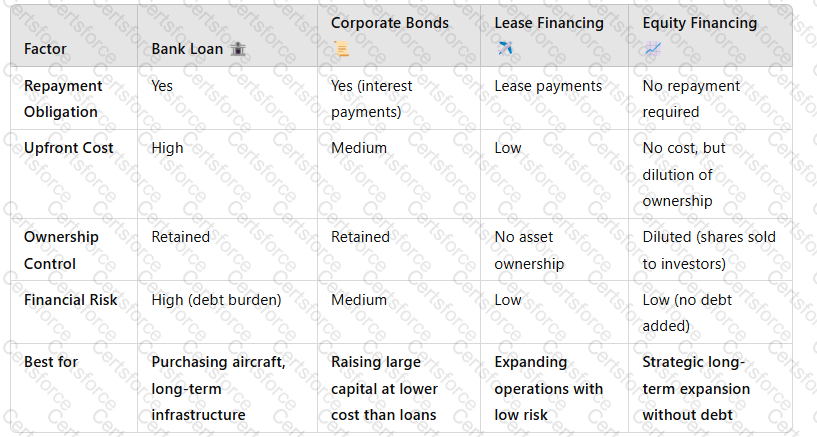
Key Takeaway:Each financing option suits different strategic needs, from ownership-based expansion to flexible leasing.
6. Recommendation: Best Financing Option for XYZ’s Expansion
✅Best Option: Lease Financing (Aircraft Leasing)✈️
Minimizes financial riskwhile expanding into Asia.
Avoids large upfront costs, preserving cash for operations.
Allows flexibilityif the new market underperforms.
Alternative Approach: Hybrid Strategy
Lease aircraft initially→ Test the Asian market.
Issue corporate bonds later→ Secure long-term funding for growth.
Consider equity financingif a strategic investor is interested.
????Final Takeaway:A combination ofleasing for operational flexibilityandcorporate bonds or equity for long-term financial strengthis the best approach for XYZ’s expansion into Asia.
Evaluate the following types of business structures: simple, functional, multi-divisional and matrix, explaining the advantages and disadvantages of each.
See the complete answer below in Explanation.
Evaluation of Business Structures: Simple, Functional, Multi-Divisional, and Matrix
Introduction
A company’s business structure defines how itorganizes its people, processes, and decision-making hierarchy. The right structure helps an organizationoperate efficiently, communicate effectively, and achieve strategic goals.
This answer evaluates four common business structures:
Simple Structure– Small, centralized decision-making.
Functional Structure– Organized by business functions (e.g., marketing, finance).
Multi-Divisional Structure– Separate divisions with decentralized decision-making.
Matrix Structure– A hybrid of functional and project-based management.
Each structure hasadvantages and disadvantagesthat impactefficiency, flexibility, and strategic execution.
1. Simple Structure????(Small, Centralized Organization)
Explanation
Asimple structureis typically used bysmall businesses or startupswithfew employees and direct leadership by the owner or CEO.
✅Key Characteristics:
Centralized decision-making.
Minimal bureaucracy and hierarchy.
Quick adaptability to changes.
????Example:Alocal retail storeorfamily-owned restaurantwhere the owner makes all key decisions.
Advantages of a Simple Structure
✔Fast decision-making– No complex approval processes.✔Flexible and adaptable– Can quickly respond to market changes.✔Low operational costs– Minimal administrative expenses.
Disadvantages of a Simple Structure
❌Lack of scalability– Difficult to manage growth.❌Over-reliance on leadership– If the owner is absent, decision-making stalls.❌Limited specialization– Employees often perform multiple roles, reducing efficiency.
????Best for:Small businesses, early-stage startups, and family-run companies.
2. Functional Structure????(Organized by Department Functions)
Explanation
Afunctional structuregroups employees based onbusiness functions(e.g., HR, finance, marketing, operations).
✅Key Characteristics:
Specialization within departments.
Clear lines of authority.
Efficient division of work.
????Example:Amanufacturing companywith dedicated teams forproduction, sales, HR, and R&D.
Advantages of a Functional Structure
✔Encourages specialization– Employees develop expertise.✔Efficient resource allocation– Reduces duplication of roles.✔Clear chain of command– Reduces confusion in reporting lines.
Disadvantages of a Functional Structure
❌Silos between departments– Poor cross-functional communication.❌Slow decision-making– Requires coordination across departments.❌Limited flexibility– Harder to respond quickly to market shifts.
????Best for:Medium to large firms in stable industries (e.g.,banks, insurance companies, government agencies).
3. Multi-Divisional Structure (M-Form)????(Organized by Business Units or Divisions)
Explanation
Amulti-divisional structureconsists ofseparate business units (divisions), each operating independently under a corporate headquarters.
✅Key Characteristics:
Decentralized decision-making at the divisional level.
Each division focuses on a specific product, market, or region.
Corporate HQ oversees strategic direction.
????Example:Unileveroperates multiple divisions forfood, beauty, and household products, each with its own leadership team.
Advantages of a Multi-Divisional Structure
✔Faster decision-making– Divisions operate autonomously.✔Better market responsiveness– Each unit focuses on its unique customers.✔Risk diversification– If one division underperforms, others can offset losses.
Disadvantages of a Multi-Divisional Structure
❌Higher operational costs– Each division requires management and resources.❌Duplication of functions– HR, marketing, and finance teams may exist in multiple divisions.❌Potential competition between divisions– Internal rivalry may slow down collaboration.
????Best for:Large corporations withdiverse product lines or global operations(e.g.,Toyota, Amazon, PepsiCo).
4. Matrix Structure????(Dual Reporting: Functional & Project-Based Teams)
Explanation
Amatrix structurecombinesfunctional and project-based management, where employeesreport to both functional managers and project leaders.
✅Key Characteristics:
Employees work oncross-functional teamswhile still belonging to their department.
Encourages collaboration between different business functions.
Enhances project efficiency and resource sharing.
????Example:NASA and consulting firms (e.g., Deloitte, PwC)use matrix structures where engineers or consultants work onmultiple projectswhile reporting to department heads.
Advantages of a Matrix Structure
✔Encourages collaboration and knowledge sharing.✔Flexible and adaptable to projects.✔Better use of company resources– Employees work across different teams.
Disadvantages of a Matrix Structure
❌Complex reporting relationships– Employees may receive conflicting instructions.❌Higher administrative costs– Requires extensive coordination.❌Slower decision-making– More meetings and discussions needed to align multiple teams.
????Best for:Project-based companies, tech firms, multinational corporations(e.g.,Google, IBM, Boeing).
5. Comparison of Business Structures
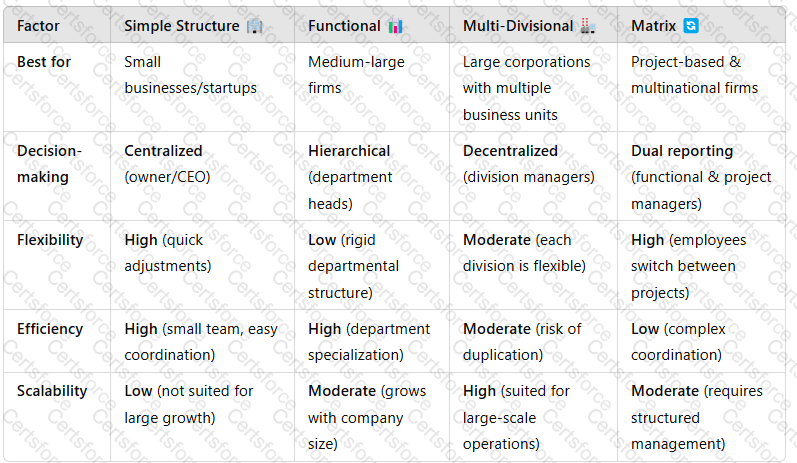 A screenshot of a computer
Description automatically generated
A screenshot of a computer
Description automatically generated
Key Takeaway:The choice of business structure depends oncompany size, industry, and strategic objectives.
Conclusion
Each business structure offersunique benefits and challenges:
✅Simple Structure– Best forsmall, agile businessesbut lacks scalability.✅Functional Structure– Encouragesefficiency and specializationbut createsdepartmental silos.✅Multi-Divisional Structure–Ideal for large firmswith diverse product lines butcan be costly.✅Matrix Structure– Encouragescollaboration and flexibilitybutis complex to manage.
Organizations must select abusiness structure that aligns with their strategic goals, operational needs, and industry requirements.
Compare and contrast an aggressive and conservative approach to business funding.
See the complete answer below in Explanation.
Comparison of Aggressive vs. Conservative Business Funding Approaches
Introduction
Businesses adopt differentfunding strategiesbased on theirrisk tolerance, growth objectives, and financial stability. Two contrasting approaches to business funding are:
Aggressive Funding Approach– Focuses onhigh-risk, high-reward strategieswithmore debt and short-term financingto fuel rapid expansion.
Conservative Funding Approach– Emphasizesfinancial stability, risk aversion, and long-term security, often relying onequity and retained earningsto fund operations.
Each approach has advantages and risks, influencing a company’sliquidity, cost of capital, and financial sustainability.
1. Aggressive Business Funding Approach????(High Risk, High Reward)
Definition
Anaggressive funding strategyinvolves maximizingshort-term debt, high leverage, and minimal cash reservestoaccelerate growth and expansion.
✅Key Characteristics:
Relies heavily on debt financing(bank loans, corporate bonds, short-term credit).
Prioritizes rapid growth and high returnsover financial security.
Uses minimal equity financingto avoid ownership dilution.
Maintains low cash reserves, assuming cash flows will cover liabilities.
????Example:
Startups and tech firms (e.g., Tesla, Uber, Amazon in early years)oftenborrow aggressivelyto scale rapidly.
Private equity firmsfund acquisitions using high leverage to maximize returns.
Advantages of Aggressive Funding
✔Faster business expansion– Capital is readily available for investments.✔Higher return potential– More funds are allocated to revenue-generating activities.✔Lower equity dilution– Existing shareholders maintain control as funding is primarily debt-based.
Disadvantages of Aggressive Funding
❌High financial risk– Heavy debt increases vulnerability to economic downturns.❌Liquidity problems– Low cash reserves can cause issues during slow revenue periods.❌Higher borrowing costs– Lenders charge higher interest due to the risk involved.
????Best for:Fast-growing companies, high-risk industries, and businesses with predictable cash flows.
2. Conservative Business Funding Approach????(Low Risk, Long-Term Stability)
Definition
Aconservative funding strategyfocuses onlow debt levels, high liquidity, and long-term financingto ensurefinancial stability and steady growth.
✅Key Characteristics:
Uses retained earnings and equity financingover debt.
Minimizes reliance on short-term creditto avoid financial pressure.
Maintains high cash reservesfor financial security.
Focuses on steady, sustainable growthrather than rapid expansion.
????Example:
Berkshire Hathaway (Warren Buffett’s company)follows aconservative funding model, relying on retained earnings rather than excessive debt.
Family-owned businessesoften prioritize financial stability over rapid expansion.
Advantages of Conservative Funding
✔Lower financial risk– Reduces dependence on external creditors.✔Stable cash flow– Ensures business continuity during economic downturns.✔Better credit rating– Stronger financial health allows for lower borrowing costs if needed.
Disadvantages of Conservative Funding
❌Slower business growth– Limited access to capital can restrict expansion.❌Missed market opportunities– Competitors with aggressive funding may outpace the company.❌Higher cost of capital– Equity financing (selling shares) dilutes ownership and reduces profit per share.
????Best for:Established businesses, risk-averse industries, and companies focusing on long-term sustainability.
3. Comparison Table: Aggressive vs. Conservative Funding Approaches
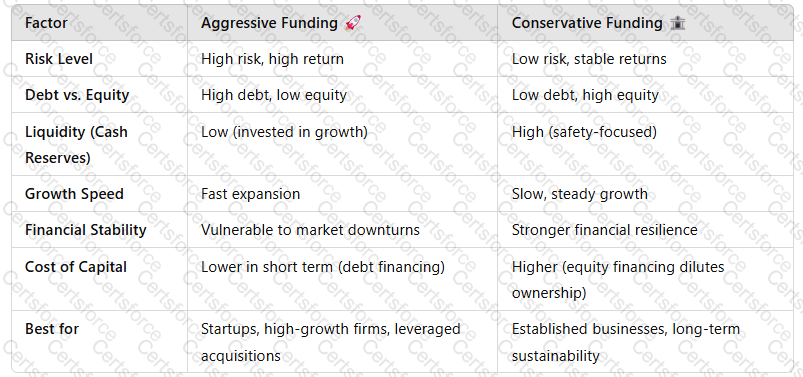 A screenshot of a computer screen
Description automatically generated
A screenshot of a computer screen
Description automatically generated
Key Takeaway:The best funding approach depends onindustry, company stage, and risk appetite.
4. Which Approach Should a Business Use?
✅Aggressive Approach is Ideal For:
Startups & High-Growth Companies– Needfast capitalto capture market share.
Businesses in Competitive Markets– Companies that mustoutpace rivals through aggressive expansion.
Private Equity & Leveraged Buyouts– Maximizing returns throughhigh debt strategies.
✅Conservative Approach is Ideal For:
Mature & Stable Businesses– Companies prioritizingsteady revenue and financial security.
Family-Owned Enterprises– Owners preferlow debt and long-term growth.
Risk-Averse Industries– Businesses inessential goods/services sectorswherestability is more important than rapid expansion.
Hybrid Approach: The Best of Both Worlds?
????Many businesses use a combination of both approaches, leveragingdebt for growth while maintaining financial stabilitythrough retained earnings and equity.
????Example:
Appleused a conservative strategy in its early years but adoptedaggressive funding for global expansionpost-2010.
5. Conclusion
The choice betweenaggressive and conservative fundingdepends on a company’sgrowth goals, financial risk tolerance, and industry conditions.
✅Aggressive funding maximizes short-term growthbut increases financial risk.✅Conservative funding ensures stabilitybut limits expansion speed.✅Most companies use a hybrid modelto balancegrowth and financial security.
Understanding these approaches helps businessesoptimize capital structure, manage risk, and align financing with strategic objectives.
Evaluate the following approaches to supply chain management: the Business Excellence Model, Top-Down Management Approach and Six Sigma
See the complete answer below in Explanation.
Evaluation of Approaches to Supply Chain Management
Introduction
Effectivesupply chain management (SCM)is critical for organizations to enhance efficiency, reduce costs, and improve customer satisfaction. Various management approaches help organizations optimize their supply chain performance. Three widely recognized approaches include:
Business Excellence Model (BEM)– A framework for continuous improvement.
Top-Down Management Approach– A hierarchical decision-making structure.
Six Sigma– A data-driven methodology for process improvement.
Each approach has strengths and limitations when applied to supply chain management.
1. Business Excellence Model (BEM) in Supply Chain Management
Explanation
TheBusiness Excellence Model (BEM)is a holistic framework used to assess and improve business performance. TheEuropean Foundation for Quality Management (EFQM) Excellence Modelis one of the most common BEM frameworks.
It focuses on9 key criteria:Leadership, Strategy, People, Partnerships & Resources, Processes, Customer Results, People Results, Society Results, and Business Performance.
Application in Supply Chain Management
✅Encouragescontinuous improvementin supplier relationships and logistics.✅Focuses oncustomer-centric supply chainstrategies.✅Promotescollaboration with suppliers and stakeholdersto optimize efficiency.
????Example:Toyota’s Lean Supply ChainfollowsBEM principlesto maintainsupplier partnerships and quality improvement.
Evaluation
✅Advantages
Provides astructured frameworkfor evaluating supply chain performance.
Enhancescollaboration between internal teams and external suppliers.
Focuses onquality management and customer satisfaction.
❌Limitations
Can becomplex and resource-intensiveto implement.
Requirescultural changeand strong leadership commitment.
2. Top-Down Management Approach in Supply Chain Management
Explanation
TheTop-Down Management Approachfollows ahierarchical structurewhere decisions are made by senior management and communicated downward. This approach ensurescentralized decision-makingandstrong leadership control.
Application in Supply Chain Management
✅Ensuresconsistency in supply chain policiesand strategic direction.✅Facilitatesquick decision-makingin procurement and logistics.✅Helps maintaincompliance with regulatory standardsand corporate policies.
????Example:Amazon’s Supply Chain Strategyis largelytop-down, with executives making key strategic decisions on warehousing, delivery, and automation.
Evaluation
✅Advantages
Ensuresstrong leadership directionin supply chain management.
Reducesconfusion in decision-makingby maintaining clear authority.
Useful forlarge-scale global supply chainsthat need standardization.
❌Limitations
Can berigid and slow to adaptto changing supply chain disruptions.
Mayreduce innovationand employee engagement in problem-solving.
Less effective indynamic, fast-changing industries.
3. Six Sigma in Supply Chain Management
Explanation
Six Sigmais adata-driven methodologyaimed at reducing defects and improving quality. Itfollows theDMAIC cycle(Define, Measure, Analyze, Improve, Control) to enhanceprocess efficiency and minimize errors.
Application in Supply Chain Management
✅Helps identifywaste and inefficienciesin supply chain processes.✅Reducesdefects and errors in procurement, logistics, and inventory management.✅Enhancessupplier performance evaluationthrough data analysis.
????Example:General Electric (GE) used Six Sigmato improvesupply chain efficiency, reducing defects and operational costs.
Evaluation
✅Advantages
Reducessupply chain disruptions by improving process reliability.
Usesdata-driven decision-makingfor procurement and logistics.
Improvessupplier quality management.
❌Limitations
Requiresintensive training and certification (Black Belt, Green Belt, etc.).
Can betoo rigid for industries requiring flexibility and innovation.
Implementation may becostly and time-consuming.
Conclusion
Each approach offers unique benefits for supply chain management:
BEMensures aholistic, continuous improvement frameworkfor supply chains.
Top-Down Managementprovidesstrong leadership direction and centralized decision-making.
Six Sigmaimprovesprocess quality and operational efficiency.
Organizations shouldcombine these approachesbased on theirbusiness model, industry requirements, and strategic goalsto optimize supply chain performance.
XYZ is a large manufacturing organisation which employs 200 skilled staff in its factory in Bolton. It has a large global supply chain with raw materials sourced from Asia and Africa. Discuss five areas of policy that can affect the people working in the supply chain
See the complete answer below in Explanation.
Five Areas of Policy Affecting People in the Supply Chain – XYZ Manufacturing
Introduction
Aglobal supply chaininvolves multiple stakeholders, including suppliers, logistics providers, and factory workers. Policies atcorporate, national, and international levelsimpact theworking conditions, rights, and well-beingof people within the supply chain.
For XYZ, alarge manufacturing company with a factory in Bolton and suppliers in Asia and Africa, key policy areas affecting its workforce and supply chain workers includelabor rights, health and safety, wages, environmental regulations, and ethical sourcing.
1. Labor Laws and Workers’ Rights Policies
Policies related toemployment laws, working hours, and fair treatmentimpact supply chain workers’ rights.
✅Key Areas of Impact
Child labor and forced laborlaws ensure ethical sourcing.
Working hours and overtime regulationsprevent worker exploitation.
Freedom of association(e.g., the right to join trade unions) allows collective bargaining.
????Example:TheInternational Labour Organization (ILO) conventionsset global labor standards, influencing suppliers in Asia and Africa.
✅Impact on XYZ
Mustaudit suppliersto ensure compliance withfair labor policies.
Risk of reputational damage if suppliers engage inunethical labor practices.
2. Health and Safety Regulations
Policies ensuringsafe working conditionsin manufacturing and supply chain operations protect employees from hazards.
✅Key Areas of Impact
Workplace safety(e.g., protective equipment, fire prevention, accident reporting).
Factory compliance withOSHA (Occupational Safety and Health Administration) standards.
COVID-19 and pandemic-related health protocolsin global supply chains.
????Example:Bangladesh’sRana Plaza factory collapse (2013)highlighted the dangers of weak safety regulations, prompting global reforms in factory safety policies.
✅Impact on XYZ
Needs to conductsupplier auditsto ensurecompliance with safety laws.
May need to invest inbetter safety trainingfor factory workers in Bolton.
3. Wages and Fair Pay Policies
Regulations and policies onminimum wages, equal pay, and fair compensationinfluence worker conditions in global supply chains.
✅Key Areas of Impact
Minimum wage lawsin supplier countries affect labor costs.
Fair pay policiesensure workers are not underpaid or exploited.
Gender pay equitypromotes inclusive employment practices.
????Example:TheUK’s National Minimum Wageensures fair pay, but wages inAsia and Africamay be significantly lower.
✅Impact on XYZ
Needs to ensure supplierspay living wagesto avoid reputational risks.
Could facesupply chain disruptionsif wage disputes lead to strikes or protests.
4. Environmental and Sustainability Policies
Environmental policies regulate how businessessource raw materials, manage waste, and reduce carbon emissions.
✅Key Areas of Impact
Deforestation and raw material sourcing laws(e.g., FSC-certified timber, conflict minerals regulations).
Carbon emissions policiesaffect logistics and transportation.
Waste disposal and pollution regulationsimpact factory operations.
????Example:TheEU’s Carbon Border Adjustment Mechanism (CBAM)affects importers sourcing from high-carbon-emitting regions.
✅Impact on XYZ
Must ensuresuppliers meet environmental standardsto avoid legal penalties.
Needs toreduce carbon footprintby choosingsustainable transportand materials.
5. Ethical Sourcing and Corporate Social Responsibility (CSR) Policies
Ethical sourcing policies ensure companies buy fromresponsible suppliersthat uphold human rights and environmental protection.
✅Key Areas of Impact
Modern Slavery Act (UK, 2015)requires firms toreport on anti-slavery efforts.
Fairtrade and ethical certificationpolicies ensure responsible supply chain practices.
CSR commitmentsrequire businesses to engage in community welfare programs.
????Example:Nestléhas anEthical Sourcing Programfor cocoa, ensuring child labor-free supply chains.
✅Impact on XYZ
Needs to conductsupplier due diligenceto comply with ethical sourcing laws.
Ethical policies canenhance brand reputation and customer trust.
Conclusion
Policies onlabor rights, health and safety, fair wages, environmental sustainability, and ethical sourcingdirectly impactpeople working in XYZ’s supply chain. To ensure compliance, XYZ must adoptrobust supplier audits, transparent reporting, and ethical business practicesto protect workers' rights while maintaining aresilient and responsible supply chain.
